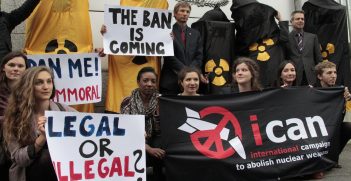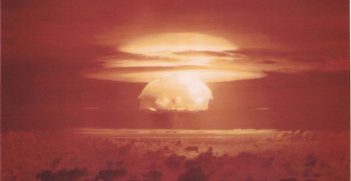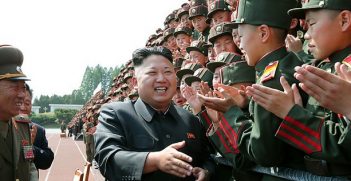Reading Room: The Doomsday Machine

The Doomsday Machine: Confessions of a Nuclear War Planner comes out 60 years after most of the events it describes have passed. Yet as its author chillingly shows, the fate of the earth is still in the hands of a few war planners in Washington and Moscow and the automatic doomsday machine they have created. Nuclear winter could still wipe out humanity from the world.
Daniel Ellsberg, a Harvard-educated whizz kid, became a precocious member of the RAND Corporation in 1959. He is universally known for his release of The Pentagon Papers which led to American capitulation in the Vietnam War. His new book might eclipse it in importance. It covers his time at RAND as a war planner before and during the Kennedy administration, and what he found out about United States’ preparedness to use or threaten to use nuclear weapons against other nations. It is essential reading if one wants to appreciate how close the world came to an end during the Cold War and how that possibility still exists because, as Ellsberg says, the basic elements of American readiness for nuclear war remain today what they were 60 years ago.
Ellsberg takes us through the Cold War, showing how the Soviets were ahead of the US in nuclear delivery systems in 1957 when they lofted Sputnik and then the dog Laika into orbit, and how the US military exploited this as a “missile gap”. At a briefing at RAND in 1959, Ellsberg blew the Soviet Gap out of the water when he revealed that the Soviets had only four soft-shell liquid-fuelled Intercontinental Ballistic Missiles (ICBMs) stationed above ground at Plesetsk inside the Arctic Circle. At the same time, the US had 40 operational Atlas and Titan ICBMs targeted on the Soviet Union (USSR), and about 120 intermediate range ballistic missiles and 60 submarine-launched Polaris missiles within the range of the USSR. But the Gap remained a useful piece of fiction for the military-industrial complex to encourage Americans to agree to spending billions on defence.
Ellsberg outlines plans sanctioned by the Air Force and Joint Chiefs of Staff, some not even known to the civilian Secretary of Defence or the White House. The most alarming was the Single Integrated Operational Plan (SIOP), designed to blanket both the USSR and China in megadeath from thermo-nuclear bombs if someone in the US military establishment decided to pull the trigger. Every city of 20,000 or more in both the USSR and China were targeted. There was no plan to attack only Russia, even if China was not involved in whatever provoked the attack.
Closely aligned to SIOP was the secret doctrine of delegating the nuclear trigger. Ellsberg shows that the widely held view that only the president can authorise a nuclear attack was a hoax. In reality, delegation had been secretly extended by the military brass down through the chain of command. During a tour of US bases in the Pacific in 1959, Ellsberg instances an Air Force major in charge of 12 F-100 fighter bombers at a rather isolated Korean base at Kunsan. Each aircraft carried under its belly a single Mark 28 hydrogen bomb of 1.1 megatons, the explosive equivalent of half the tonnage the US dropped in Europe and the Pacific in all of World War Two. The major told Ellsberg that if he was cut off from communications with US forces in Japan (a regular occurrence), and if he thought the Soviets had already launched an attack, he would probably override his instructions and unleash his 12 aircraft on pre-determined targets in North Korea, China or eastern Russia.
Another lie uncovered by Ellsberg concerns breaches of a US undertaking never to introduce or station nuclear weapons in Japan. During his inspection of US bases in 1960, Ellsberg discovered that San Joaquin County, an American Landing Ship Tank (LST) permanently moored in the US naval base at Iwakuni, was a storage facility of hydrogen bombs for US Navy ships and aircraft. Its presence was kept secret from the Japanese, who would have called for the withdrawal of the LST and the abrogation of the US Japan Security Treaty. The LST was not withdrawn from Iwakuni until ordered out by Kennedy’s new ambassador to Japan Edwin O. Reischauer in 1966.
The uncomfortable truth was that throughout Ellsberg’s tenure at RAND, he observed that the US military brass had no confidence in their civilian masters and wanted to be able to launch pre-emptive nuclear strikes against Communist bloc countries (or anywhere else) at their discretion. He quoted Curtis LeMay, the man responsible for the slaughter of hundreds of thousands of civilians in fire bombings in Tokyo in 1945 and North Korea in 1952-3 and then head of Strategic Air Command, as he talked about command and control:
Command and control! Command and control! What’s that? Its telling the fighting man what to do, that’s what it is. And that’s a job for professional soldiers. They talk about the president exercising command and control. What is the president? He spat out the ‘p’ in ‘president’. ‘A politician. And what does a politician know about war?’ He dwelled on w-a-a-h-r. ‘Who needs the president if there’s a w-a-a-h-r? Nobody!’
In drier, more efficient prose, Ellsberg outlines the nuclear flash points in the Berlin crisis of 1961 and Cuban missile crisis of 1962, either of which could have caused an unbridled nuclear exchange between the US and the USSR. He discusses how millions of tonnes of debris from cities burned by nuclear weapons could cause nuclear winter which would prevent the growth of crops and the elimination of human kind through starvation, something not factored in by gung-ho war planners during the early days of the Cold War.
Ellsberg ends his narrative with the timely warning that substantial numbers of American and Russian nuclear weapons remain on hair-trigger alert. That a miscalculation, computer malfunction or strangelovian piece of mischief-making could still result in the demise of life on our planet. What is strange in this context is the insistence of the nuclear powers and their acolytes like Australia that they need nuclear weapons for their defence, but that other countries don’t. Despite growing international rejection of nuclear weapons, the nuclear powers remain obdurate. Ellsberg’s book should be a timely wake-up call to the more thoughtful war planners among them.
Review by Richard Broinowski, immediate past-president of AIIA NSW and former Australian Ambassador to Vietnam, Korea, Mexico, the Central American Republics and Cuba.
This article is published under a Creative Commons Licence and may be republished with attribution.





